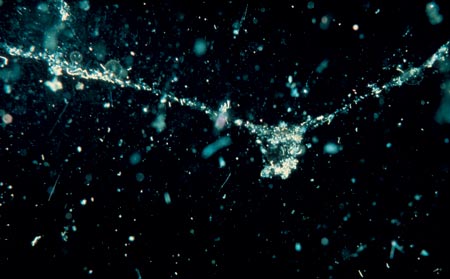Plus!: Creepy crawling lilies of the deep! They will astound you!
 |
| An image of marine snow, little gooey particles of a variety of organic matter that slowly sink to the bottom of the ocean, also known as marine detritus. Marine snow plays an incredibly important role in the ocean's carbon cycle and is a major source of food for deep-sea organisms. Image from Woods Hole Oceanographic Institute. |
So this one's for Leslie: D on a subject in oceanography.
I chose to write about an important part of about 2/3s of my PhD thesis: marine snow, also known as marine detritus.
What is detritus? Well, it's the pieces of organic material - some of it dead organisms and fish feces, but also a large part sinking dead phytoplankton, zooplankton and bacteria. Phytoplankton are tiny plants living in the oceans. Zooplankton are very tiny animals and other heterovores living in the ocean.
So yes. I built computer models of sinking fish poop for my PhD. :-) (Okay, not fish there, just plants, but you get my point.)
But something more wonderful and interesting than that are detritovores, all the wonderful and interesting creatures that swim through the water or live on the bottom and eat the plentiful, glittering poo-snow as it rains down from the near-surface of the water.
Most food in the ocean is made in a thin layer called the euphotic zone, or "beautiful light zone," which is only the first 100-200 meters (about 300-600 feet) of the ocean.
The creature who live below that have to wait for their Christmas presents from above in the form of (among other things) detritus.
One really cool group are the sea lilies. In the geologic record they're better known as crinoids.
 |
| A sea lily. That's an animal, not a plant. |
 |
| Another sea lily. It's eating the detritus floating in the water around it. From NOAA. |
And in the weirdest of the weird.... I bet most science fiction writers have never seen anything like this!:
And that's detritus (the falling bits of organic matter that help sustain life in the deep ocean.) As an added bonus, a little on one type of detritovore, or detritus-eater. Plus a creepy lily that can crawl!
****
Coming up in future posts:
photowannabe, animals, "E"
PhenoMenon, astronomy, "F"
Carver, conservation of natural resources, "G"
ChrisJ, botony, "H"
LC Scotty, statistical mechanics, "I"
mrsnesbitt, biology, "J"
Black Jack Carol, physics of sound, "K"
Have a science topic that interests you? Let me know! You can even ask for more than one!
You really ARE s@#$%ing us! But in an informative way!
ReplyDeleteROG, ABC Wednesday team
Thank you? :-) I try.
DeleteThanks for dropping by!
No dumbing down here!!! LOVE the post and the video - very sci-fi with the 'walking flower' (And you're right sometimes we might need to lose a few if we're taking others to places never gone before - so to speak).
ReplyDeleteHave a great week!!!
Thanks. I LOVE your blog. It asks really important questions. Those are the discussions that we as educators should be having.
DeleteThank you again for the visit,
Chris
I have never seen anything like that before.
ReplyDeleteTotally fascinating.
Your thesis on poop would have been quite a piece of work to read. (:0)
Most of it is math. Math and poop. (Yikes. How boring and weird do I sound?!?!?!)
DeleteThanks for the visit!
Some of this info is very DEEP - too DEEP for a grade 4 teacher who taught about the ocean as a habitat and had kids watch Bill Nye the Science Guy. Fascinating, though! Thanks for doing this for us - poop can always be interesting no matter where it comes from or goes to! lol
ReplyDeleteLeslie
abcw team
You can make another request. The next one will be a double "E" - Elephant Evolution.
DeleteBut if there's something that your students are covering that you'd like some links or projects, etc. for I'm happy to help.
For my masters I was part of a fellowship called "Scientists Kids and Teachers." Rather than just doing a TA-ship (teaching at the university), I taught also at an elementary school and helped develop curriculum. I really think that starting early is the best place to begin.
Thanks for dropping by!
This is freaking fantastic! I think the undersea world is just as amazing as outer space. And much, much closer. Thanks for educating us in such a fun way.
ReplyDeleteThank you for visting!
DeleteThanks for your entry! Deepsea life is very interesting and still very mysterious. I saw the Great Barrier Reef twice and was impressed by the beauty of these very old coral formations. Thanks for your visit!
ReplyDeleteWil, ABC Team.
Thanks for your visit as well!
DeleteThe yellow sea lily is beautiful. Catching up With ABC.
ReplyDeleteDaredevil Diva
Rose, ABC Wednesday Team
Thanks. Check out NOAA and WHOI for more great undersea pics.
DeleteGreat word for D day. Carver, ABC Wed. Team
ReplyDeleteThank you!
DeleteI am always fascinated by deep sea creatures, how they live in such a cold and apparently barren world.....nice post
ReplyDeleteYes, very little food is made down there. I might do a post on one of the rare ecosystems that isn't ultimately dependent on plants for energy: deep sea hydrothermal vents. Totally separate part of the world!
Delete